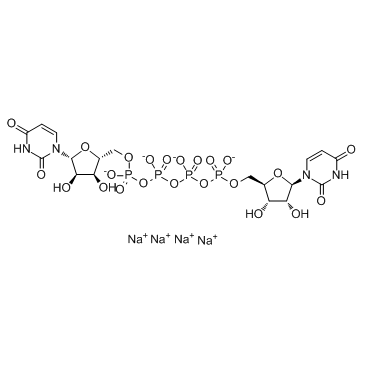Diquafosol Tetrasodium
Modify Date: 2025-08-20 15:43:25

Diquafosol Tetrasodium structure
|
Common Name | Diquafosol Tetrasodium | ||
|---|---|---|---|---|
| CAS Number | 211427-08-6 | Molecular Weight | 878.23 | |
| Density | N/A | Boiling Point | N/A | |
| Molecular Formula | C18H22N4Na4O23P4 | Melting Point | N/A | |
| MSDS | N/A | Flash Point | N/A | |
Use of Diquafosol TetrasodiumDiquafosol tetrasodium is a P2Y2 receptor agonist that stimulates fluid and mucin secretion on the ocular surface, as a topical treatment of dry eye disease. |
| Name | Diquafosol Tetrasodium |
|---|---|
| Synonym | More Synonyms |
| Description | Diquafosol tetrasodium is a P2Y2 receptor agonist that stimulates fluid and mucin secretion on the ocular surface, as a topical treatment of dry eye disease. |
|---|---|
| Related Catalog | |
| In Vitro | Cell viability significantly decreased after treatment with 30% diluted diquafosol for 1 hour and 6 hours after treatment with 10% and 20% diluted diquafosol. Twenty-four hours after wounding monolayers, 3% diquafosol, and 0.3% HCECs exhibits significantly more wound healing than the control[1]. |
| In Vivo | In a rat dry eye model, the P2Y2 agonist diquafosol tetrasodium is found to improve surface health, based on increases in tear fluid secretion, corneal epithelial resistance, and release of glycoprotein-containing moieties from goblet cells. Beginning at 2 weeks and continuing for an additional 2 weeks, maximal declines in dye penetrance of approximately 50% occurred with doses of diquafosol tetrasodium as low as 1%[2]. INS365 significantly suppresses corneal damage at concentrations of more than 0.1% w/v[3]. |
| Cell Assay | The viabilities of human corneal epithelial cells (HCECs) are determined using a MTT assay. Cells are subconfluent Diquafosol (100 mL diluted 10%, 20%, or 30%) or DMEM (100 mL) is added to controls. After 1, 6, and 24 h, plates are washed three times with PBS to remove the drugs. Cell viabilities are evaluated after incubating for 24 h. MTT is then added to each well. Samples are incubated in the dark for 4 h at 37oC, and media are then removed. Precipitates are resuspended in DMSO. Absorbances are measured on a plate reader at 570 nm[1]. |
| Animal Admin | Rats: An SD rat dry eye model is used in which exorbital lacrimal gland extirpation decreased the Schirmer test score by at least 50%. After 8 weeks, when significant increases occurred in corneal epithelial permeability, INS365-containing eye drops are applied six times daily for the next 4 weeks at concentrations from 0.03% to 3.0%. Corneal barrier function is evaluated based on measurements with a modified anterior fluorometer of fluorescein penetrance at 1, 2, and 4 weeks after initial application. After INS365 application, the periodic acid–Schiff reagent (PAS)–stained area is evaluated in histologic sections of the tarsal and bulbar conjunctiva[2]. |
| References |
| Molecular Formula | C18H22N4Na4O23P4 |
|---|---|
| Molecular Weight | 878.23 |
| Diquafosol Impurity 7 |